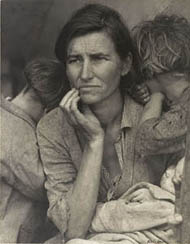Grades/Level: Lower Elementary (K–2), Upper Elementary (3–5), Middle School (6–8), High School (9–12)
Subjects: Visual Arts
Time Required: Short Activity
30 minutes
Author: J. Paul Getty Museum Education Staff
|
 |
 |
This activity prepares students for the Guided Lesson in the Museum at the Getty Center, Body Language. Students will look at Dorothea Lange's photograph of a migrant mother and consider how artists express emotions, ideas, and physical conditions through gesture, pose, clothing, and expression. |
 |
 |
Students should be able to:
• look closely at, and think creatively about, works of art.
• use their own observations to actively construct meaning about art objects and to explore concepts about art and culture.
• provide students with opportunities and tools for an engaging and enjoyable gallery learning experience. |
 |
 |
Explain to your students that the topic of their gallery lesson in the Museum at the Getty Center will be Body Language. This activity will help them start thinking about what they can learn by studying a figurative work of art. During the lesson, it will be important for them to slow down, look carefully, and describe what they see.
Step 1: Before displaying the image, ask students to think about what they can tell about a person just by looking at their body language, their gesture, pose, clothing, and expression. Discuss their ideas as a group.
Step 2: Display an image of Dorothea Lange's photograph Human Erosion in California (Migrant Mother). Ask your students to spend a quiet minute just looking closely at the image. Before you begin the activity you may want to explain to your students that this is an image of a photograph in the Getty collection. A female photographer, named Dorothea Lange, created the original photograph in 1936, less than a century ago, here in California.
Step 3:Depending upon the grade level of your students, ask and discuss some or all of the following questions:
• What is going on in this picture?
• Who is in this picture? Do you think they are related? What do you see in the picture that gives you clues about how they are related?
• How would you describe the woman's expression?
• What does the woman's gesture tell you about how she is feeling?
• Look closely at children's poses and clothing. What do you imagine they are thinking and feeling?
• If you could ask the woman one question, what would it be?
• How do you feel when you look at this photograph?
• How do you think the photographer wanted you to feel looking at this picture?
• Why do you think the photographer took this picture? What was her goal?
• How do you think the public responded to this photograph when it was published in a newspaper in the mid-1930s?
• Does this photograph remind you of anything you have seen or experienced in your own life?
• What title would you give this picture? Does it need a title?
• Years after this photograph was taken, Florence Owens Thompson did not want this picture published anymore because she felt it labeled her as "poor" when she no longer was. If it had been up to you, would you have honored her request? If a subject agrees to be photographed, should they be able to control how the photo is later used?
Step 4: Ask your students to remember back to the first moment they saw this image. What new thoughts do they have about the picture now that they have been looking at it for several minutes?
Step 5: Share some background information with your students. To learn more about Dorothea Lange and the Great Depression and to download grade specific lesson plans, visit the Getty's online curriculum, About Life: The Photographs of Dorothea Lange Curriculum. This curriculum, which focuses on Dorothea Lange and her photography, helps students to visualize history and explore their own creativity through art and writing activities. |
 |
 |
 |
| Human Erosion in California (Migrant Mother), Dorothea Lange |
 |
|
The following content standards will be covered in your Guided Lesson at the Getty Center.
Visual Arts Content Standards for California Public Schools
Artistic Perception
1.0 Processing, Analyzing, and Responding to Sensory Information through the Language and Skills Unique to the Visual Arts
Students perceive and respond to works of art, objects in nature, events, and the environment. They also use the vocabulary of the visual arts to express their observations.
Historical and Cultural Context
3.0 Understanding the Historical Contributions and Cultural Dimensions to the Visuals Arts
Students analyze the role and development of the visuals arts in past and present cultures throughout the world, noting human diversity as it relates to the visual arts and artists.
Aesthetic Valuing
4.0 Responding to, Analyzing, and Making Judgments about Works in the Visual Arts
Students analyze, assess, and derive meaning from works of art, including their own, according to the elements of art, the principles of design, and aesthetic qualities.
|
 |

|

